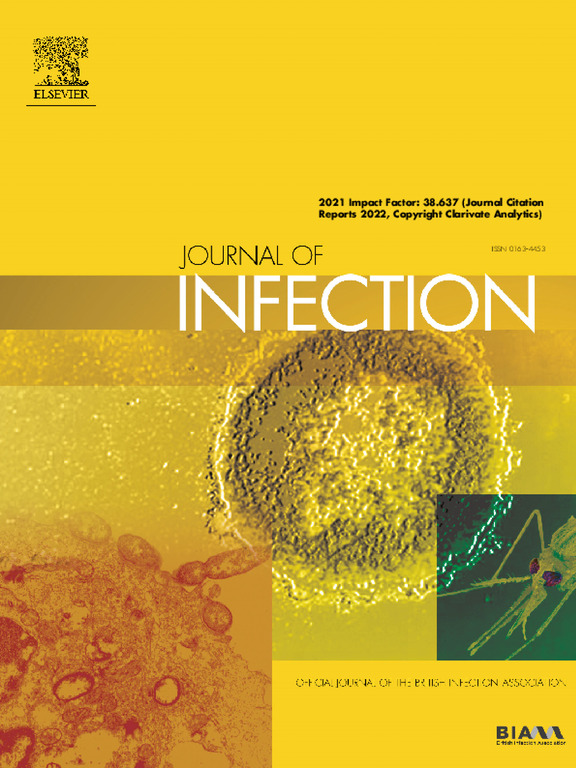An electronic health record-wide association study to identify populations at increased risk of E. coli bacteraemia
IF 11.9
1区 医学
Q1 INFECTIOUS DISEASES
引用次数: 0
Abstract
Objectives
Escherichia coli bacteraemias have been under mandatory surveillance in the UK for fifteen years, but cases continue to rise. Systematic searches of all features present within electronic healthcare records (EHRs), described here as an EHR-wide association study (EHR-WAS), could potentially identify under-appreciated factors that could be targeted to reduce infections.
Methods
We used data from Oxfordshire, UK, and an EHR-WAS method developed for use with large-scale COVID-19 data to estimate associations between E. coli bacteraemia cases, hospital-exposed controls, and 377 potential risk factors using Poisson regression models adjusted for potential confounders for three two-year financial year (FY) periods.
Results
FY2022/23–2023/24 analysis included 757 (0.3%) cases and 276,758 (99.7%) controls. We identified six broad disease areas associated with increased or decreased E. coli bacteraemia risk. Renal/urological/urinary tract infection-related variables had the largest impact, with 47% of cases theoretically removed if these factors could be minimised. Cancer-related variables were associated with higher E. coli bacteraemia risk (1.20 times higher (95%CI 1.08–1.34) per three months closer to chemotherapy in the last year), as were gastrointestinal- and infectious disease-related variables. Cardiac/respiratory-related variables were associated with lower E. coli bacteraemia risk, whereas greater healthcare exposure showed no consistent effect. Associated factors varied across periods, but broad groups remained similar.
Conclusions
Applying an EHR-WAS approach, we show E. coli bacteraemias are largely driven by known risk factors and frailty, highlighting the importance of monitoring these factors and targeting modifiable risks where possible.
一项电子健康记录协会研究,以确定大肠杆菌血流感染风险增加的人群。
目的:大肠杆菌血症在英国已经被强制监测了15年,但病例继续上升。系统地搜索电子医疗记录(ehr)中存在的所有特征,这里称为EHR-WAS研究,可以潜在地识别出被低估的因素,这些因素可以作为减少感染的目标。方法:我们使用了来自英国牛津郡的数据,并采用EHR-WAS方法开发了用于大规模COVID-19数据的方法,使用泊松回归模型调整了三个两年财政年度(FY)期间的潜在混杂因素,以估计大肠杆菌菌血症病例、医院暴露对照和377个潜在危险因素之间的关联。结果:2022/23-2023/24财年包括757例(0.3%)病例和276,758例(99.7%)对照。我们确定了与大肠杆菌菌血症风险增加或减少相关的六个广泛疾病领域。肾脏/泌尿系统/尿路感染相关变量的影响最大,如果这些因素可以最小化,理论上可以消除47%的病例。癌症相关变量与较高的大肠杆菌血症风险相关(去年接近化疗的每三个月高1.20倍(95%CI 1.08-1.34)),胃肠道和传染病相关变量也是如此。心脏/呼吸相关变量与较低的大肠杆菌血症风险相关,而较高的医疗保健暴露则没有一致的影响。相关因素在不同时期有所不同,但总体群体保持相似。结论:应用EHR-WAS方法,我们发现大肠杆菌菌血症在很大程度上是由已知的危险因素和脆弱性驱动的,强调了监测这些因素和在可能的情况下针对可改变风险的重要性。
本文章由计算机程序翻译,如有差异,请以英文原文为准。
求助全文
约1分钟内获得全文
求助全文
来源期刊

Journal of Infection
医学-传染病学
CiteScore
45.90
自引率
3.20%
发文量
475
审稿时长
16 days
期刊介绍:
The Journal of Infection publishes original papers on all aspects of infection - clinical, microbiological and epidemiological. The Journal seeks to bring together knowledge from all specialties involved in infection research and clinical practice, and present the best work in the ever-changing field of infection.
Each issue brings you Editorials that describe current or controversial topics of interest, high quality Reviews to keep you in touch with the latest developments in specific fields of interest, an Epidemiology section reporting studies in the hospital and the general community, and a lively correspondence section.
 求助内容:
求助内容: 应助结果提醒方式:
应助结果提醒方式:


